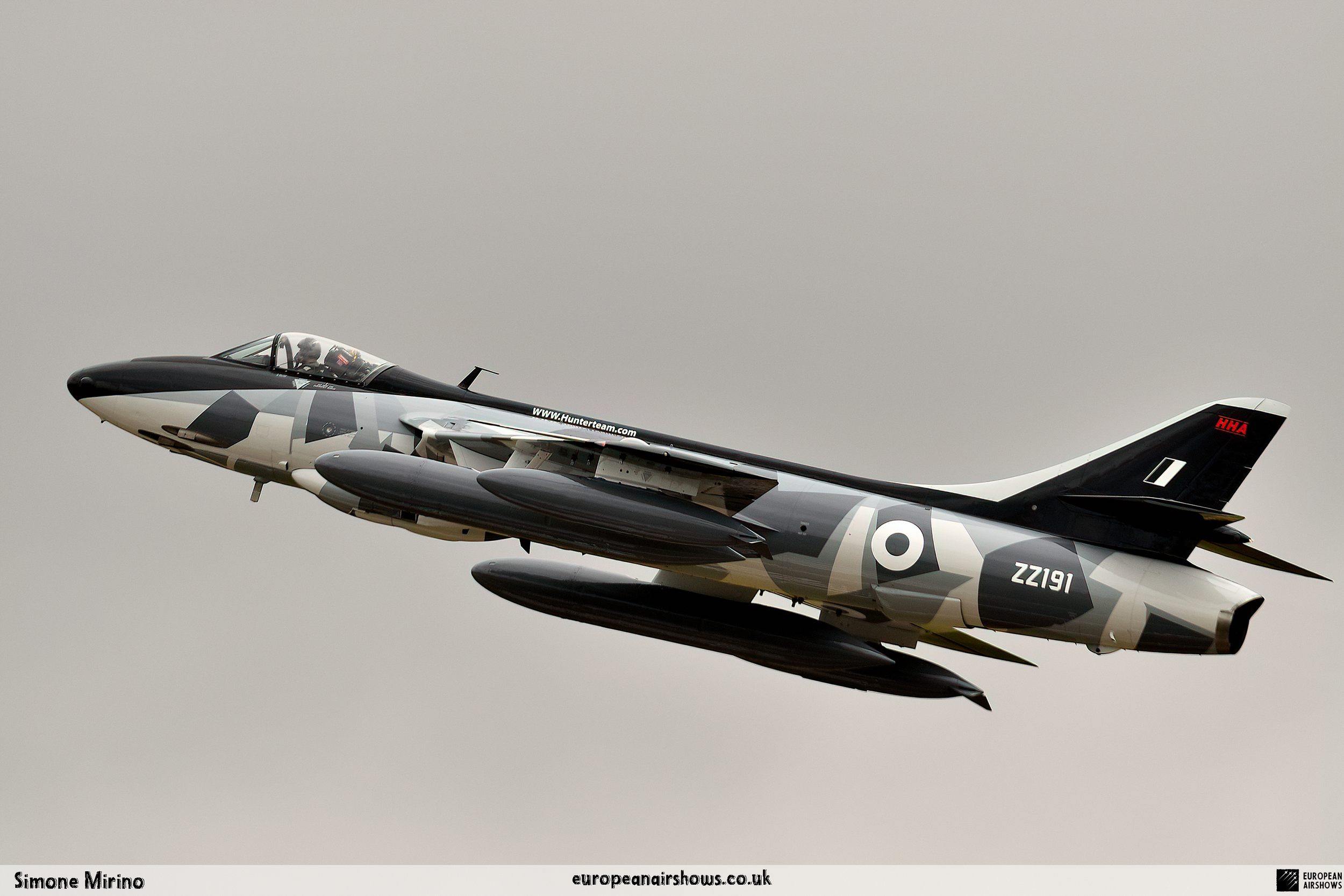
July 20 / Hawker Hunter first flight
First Flight 20 July 1951
Hawker Hunter
The Hawker Hunter is a transonic British jet-powered fighter aircraft that was developed by Hawker Aircraft for the Royal Air Force (RAF) during the late 1940s and early 1950s. It was designed to take advantage of the newly developed Rolls-Royce Avon turbojet engine and the swept wing, and was the first jet-powered aircraft produced by Hawker to be procured by the RAF. On 7 September 1953, the modified first prototype broke the world air speed record for aircraft, achieving a speed of 727.63 mph (1,171.01 km/h; 632.29 kn).
The single-seat Hunter was introduced to service in 1954 as a manoeuvrable day interceptor aircraft, quickly succeeding first-generation jet fighters in RAF service such as the Gloster Meteor and the de Havilland Venom. The all-weather/night fighter role was filled by the Gloster Javelin. Successively improved variants of the type were produced, adopting increasingly more capable engine models and expanding its fuel capacity amongst other modifications being implemented. Hunters were also used by two RAF display teams: the "Black Arrows", who on one occasion looped a record-breaking 22 Hunters in formation, and later the "Blue Diamonds", who flew 16 aircraft. The Hunter was also widely exported, serving with a total of 21 overseas air forces.
During the 1960s, following the introduction of the supersonic English Electric Lightning in the interceptor role, the Hunter transitioned to being operated as a fighter-bomber and for aerial reconnaissance missions, using dedicated variants for these purposes. Two-seat variants remained in use for training and secondary roles with the RAF and the Royal Navy until the early 1990s. Sixty years after its original introduction it was still in active service, being operated by the Lebanese Air Force until 2014.
The Hunter saw combat service in a range of conflicts with several operators, including the Suez Crisis, the Aden Emergency, the Sino-Indian War, the Indo-Pakistani War of 1965, the Indo-Pakistani War of 1971, the Rhodesian Bush War, the Second Congo War, the Six-Day War, the War of Attrition and the Yom Kippur War. Overall, 1,972 Hunters were manufactured by Hawker Aircraft and its successor, Hawker Siddeley, as well as being produced under licence overseas. In British service, the Hunter was replaced in its principal roles by the Lightning, the Hawker Siddeley Harrier and the McDonnell Douglas F-4 Phantom II.
In 1945, the Second World War came to a close and a new postwar Labour government, headed by Clement Attlee, came to power in Britain. The incoming Attlee government's initial stance on defence was that no major conflict would occur for at least a decade, and thus there would be no need to develop or procure any new aircraft until 1957. In accordance with this policy, aside from a small number of exceptions such as what would become the Hawker Sea Hawk for the Royal Navy, the majority of Specifications issued by the Air Ministry for fighter-sized aircraft during the late 1940s were restricted to research purposes. Aviation author Derek Wood describes this policy as being: "a fatal error of judgement which was to cost Britain a complete generation of fighters and heavy bomber aircraft".
As the Cold War arose in the late 1940s, the RAF came to recognise that it would urgently require the development and procurement of fighters equipped with features such as swept wings. By this time, it had also become apparent that newly developed jet propulsion would form the future of fighter aircraft development. Many companies were quick to devise their own designs to harness this means of propulsion. Hawker Aviation's chief designer, Sydney Camm, had proposed the Hawker P.1040 for the RAF, but the demonstrator failed to interest them. Further modifications to the basic design resulted in the Hawker Sea Hawk carrier-based fighter. However, the Sea Hawk possessed a straight wing and was powered by the Rolls-Royce Nene turbojet engine, both features that rapidly became obsolete.
Seeking better performance and fulfilment of the Air Ministry Specification E.38/46, Sydney Camm designed the Hawker P.1052, which was essentially a Sea Hawk outfitted with a 35-degree swept wing. Performing its first flight in 1948, the P.1052 demonstrated good performance and conducted several carrier trials, but was ultimately determined to not warrant further development into a production aircraft. As a private venture, Hawker proceeded to convert the second P.1052 prototype into the Hawker P.1081 with swept tailplanes, a revised fuselage, and a single jet exhaust at the rear. On 19 June 1950, the P.1081 conducted its maiden flight, and was promising enough to draw interest from the Royal Australian Air Force (RAAF); however, further development was stalled by difficulties with the engine's reheat. In 1951, the sole P.1081 prototype was lost in a crash.
In 1946, the British Air Ministry issued Specification F.43/46, which sought a daytime jet-powered interceptor aircraft. Camm promptly prepared a new design for a swept-winged fighter that would be powered by the upcoming Rolls-Royce Avon turbojet. The Avon's major advantage over the earlier Nene engine, as used in the earlier Sea Hawk, was adoption of the axial compressor, which allowed for a much smaller engine diameter and provided greater thrust; this single engine gave roughly the same power as the two Rolls-Royce Derwents of the Gloster Meteors, a fighter aircraft that would be replaced by the envisioned new aircraft. In March 1948, the Air Ministry issued a revised Specification F.3/48, which demanded a speed of 629 mph (1,010 km/h) at 45,000 ft (13,700 m) and a high rate of climb, while carrying an armament of four 20 mm (0.79 in) or two 30 mm (1.18 in) cannon (rather than the large-calibre gun demanded by earlier specifications). Initially fitted with a single air intake in the nose and a T-tail, the project rapidly evolved into the more familiar Hunter shape. The intakes were moved to the wing roots to make room for weapons and radar in the nose, and a more conventional tail arrangement was devised as a result of stability concerns.
In 1950, the outbreak of the Korean War and Britain's heavy involvement in this conflict led to a flurry of orders being issued; the need for capable modern interceptors was felt to be so pressing that the RAF was willing to consider accepting interim fighter aircraft while more capable fighters would continue to be pursued. In particular, the RAF felt that a pair of proposed fighter aircraft from Hawker Aircraft and Supermarine were of high importance and thus placed orders for these proposed fighters 'off the drawing board' in 1950. The reasoning behind these two aircraft being ordered in 1950 was intended to serve as an insurance policy in the event of either one of these projects failing to produce a viable aircraft; these two aircraft would later become known as the Supermarine Swift and the Hawker Hunter respectively.
On 20 July 1951, the P.1067 made its maiden flight, flown by Neville Duke, from RAF Boscombe Down, powered by a single 6,500 lbf (28.91 kN) Avon 103 engine. The second prototype, which was fitted with production-standard avionics, armament and a 7,550 lbf (33.6 kN) Avon 107 turbojet, first flew on 5 May 1952. As an insurance against development problems on the part of the Avon engine, Hawker modified the design to accommodate another axial turbojet, the 8,000 lbf (36 kN) Armstrong Siddeley Sapphire 101. Fitted with a Sapphire, the third prototype flew on 30 November 1952.
On 16 March 1953, the first production standard Hunter F.1, fitted with a single 7,600 lbf (34 kN) Avon 113 turbojet, made its first flight. The first 20 aircraft were, in effect, a pre-production series and featured a number of "one-off" modifications such as blown flaps and area-ruled fuselage. On 7 September 1953, the sole Hunter Mk 3 (the modified first prototype, WB 188) flown by Neville Duke broke the world air speed record for jet-powered aircraft, attaining a speed of 727.63 mph (1,171.01 km/h) over Littlehampton, West Sussex. This world record stood for less than three weeks before being broken on 25 September 1953 by Hunter's early rival, the Supermarine Swift, flown by Michael Lithgow.
Hawker Hunter Facts
Design and Development: The Hawker Hunter was designed by Sir Sydney Camm, a renowned British aircraft designer who also designed the Hawker Hurricane. The Hunter was developed in the late 1940s and early 1950s to meet the Royal Air Force’s (RAF) need for a high-speed jet interceptor.
First Flight: The prototype of the Hawker Hunter, designated the P.1067, made its maiden flight on July 20, 1951. The aircraft demonstrated impressive performance and handling characteristics from the outset.
Record-Breaking Speed: On September 7, 1953, a modified Hawker Hunter, piloted by Neville Duke, set a world air speed record of 727.63 mph (1,171.01 km/h) over a 3 km course. This achievement underscored the Hunter’s advanced aerodynamic design and powerful engine.
Operational Service: The Hawker Hunter entered operational service with the RAF in 1954. It quickly became a mainstay of the RAF’s fighter and ground-attack capabilities and remained in frontline service for over a decade.
Versatile Roles: The Hunter was designed primarily as an interceptor, but it proved to be highly versatile. It was adapted for various roles, including ground attack, reconnaissance, and training. Its adaptability made it a valuable asset for many air forces around the world.
Export Success: The Hawker Hunter was one of the most widely exported British jet fighters. It was used by over 20 countries, including India, Switzerland, Sweden, Saudi Arabia, and Singapore. Its reliability and performance made it a popular choice for many air forces.
Combat Proven: The Hunter saw combat in several conflicts, including the Suez Crisis (1956), the Indo-Pakistani Wars (1965 and 1971), and various Middle Eastern conflicts. It was praised for its robustness, agility, and effectiveness in combat situations.
Design Features: The Hunter featured a sleek, swept-wing design with a single Rolls-Royce Avon turbojet engine. Its design included innovations such as a pressurized cockpit, an ejection seat, and advanced avionics for its time.
Long Service Life: The Hunter had an exceptionally long service life, with some aircraft remaining in operational use for over 50 years. The Swiss Air Force, for example, retired its last Hunter aircraft in 1994.
Legacy and Preservation: The Hawker Hunter remains an iconic aircraft in aviation history. Several Hunters are preserved in museums and by private collectors around the world. Some are still airworthy and participate in air shows, demonstrating the enduring legacy of this classic jet fighter.














